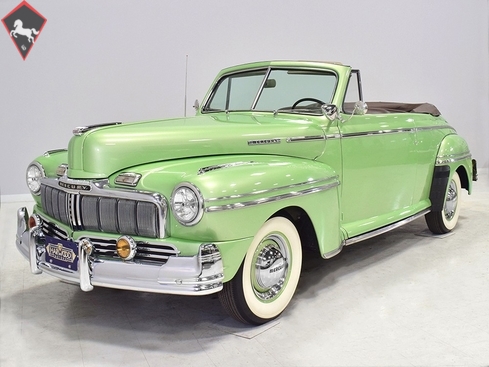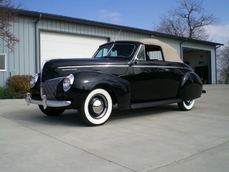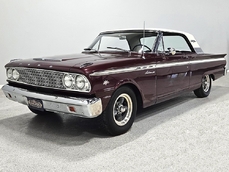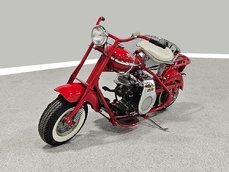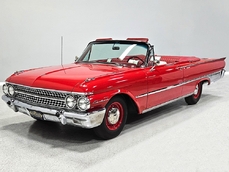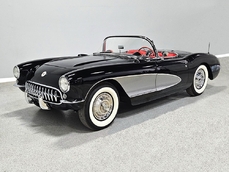Mercury Deluxe 239 cubic inch flathead V8 1947
Allgemeine Beschreibung :
It’s a mistake to think of Mercury as simply a re-badged Ford, and from its debut in 1939 to the day this handsome 1947 Mercury convertible coupe was built, they occupied a spot in the line-up more akin to an Oldsmobile or Buick. A bit bigger, a bit more horsepower, a bit more chrome, and a bit more sophistication all make choosing a Mercury over a Ford an easy decision. This particular Merc has been nicely restored with a few upgrades that make it a fantastic cruiser and very easy to live with, and none of those changes erase the genuinely fun road manners that you get with a flathead V8. This isn’t a car for the purist, but I can’t say that it doesn’t appeal to me in a big way simply because it asks for so little and delivers so much. Come try it on and you’ll see what I mean.
That bright green paint wasn’t on the color chart for 1947, but it doesn’t look wrong on the curvy Mercury bodywork, either. There’s a hint of metallic in the final finish and it just glows out in the sunlight, making this car impossible to miss. Underneath, however, none of the factory bodywork was altered, all the original chrome and stainless trim was retained, and it still looks like a car from 1947 is supposed to look. Although it looks very much like the post-war Fords, the Mercury sits on a 4-inch longer wheelbase and none of the body panels are interchangeable—in the flesh, the Merc looks quite a bit more substantial. The familial resemblance is undeniable, but Mercurys received that unique “electric shaver” grille, extra stainless trim on the fenders, and unique emblems and badging that mean it can be recognized at a glance. During the comprehensive restoration, all that brightwork was restored, including the bumpers, which feature rare (and very expensive) bumper ends that really dress the car up nicely. Other accessories include fog lights, a spotlight on the driver’s A-pillar, and a set of aftermarket blue dot headlights that light up the road like flamethrowers at night. Workmanship is quite good, with straight bodywork, good fit and finish, and an overall feeling that the car is well-assembled and durable, which is surely how it felt when it was new.
The two-tone interior was freshened using soft leather instead of the original vinyl, and it makes a difference from the moment you slide behind the wheel. The handsome seat covers were custom made to match the original look and there’s new padding underneath so it’s comfortable for long drives. Matching door panels in the original style were created at the same time and there are fresh carpets and mats on the floor, all bound to look like they were born there. The dash was obviously repainted to match the bodywork and retains its original plastic moldings and original gauges, all of which are operational. The electrical system has been converted to 12 volts so things like the wipers and radio have been updated in the interest of making driving a bit safer and more interesting, and we like that they worked hard to retain things like the accessory under-dash heater. Overhead there’s a beautifully made canvas convertible top, and it folds easily with a touch of a knob under the dash then stashes under a matching vinyl boot. The trunk is trimmed to match the interior, with new bulkheads and carpets, as well as a matching full-sized spare tire that’s never been used and a remote CD changer. Nice!
Mercurys received the same bulletproof 239 cubic inch flathead V8 used in other post-war Fords, and there’s really no better choice for fun in an old car. This one has been fully rebuilt using a stock bottom end and a few period performance upgrades, including Offenhauser aluminum heads and a matching intake with twin Stromberg 97s on top. The 12-volt electrical system means an electronic ignition system is part of the deal, as well as a big chrome alternator on top that looks like a vintage generator. There’s fresh wiring, a new fuel system with an electric fuel pump and regulator system, and a big radiator fed by twin polished stainless inlet tubes. Hit the starter button and the well-tuned flatty barks to life easily and idles with a bubbly idle that suggests the Merc wants to go out and play. There’s plenty of horsepower on tap, and the experience isn’t all that far removed from a stock flathead, making this convertible feel suitably vintage without being a sitting duck in traffic. It’ll cruise happily at 60 MPH all day and makes all kinds of great sounds while it’s doing it.
Underneath, the chassis and floors are in excellent condition with no signs that it was ever a rusty car. The stock 3-speed manual has a fresh clutch that doesn’t have the usual flathead chatter, even in reverse, and the original rear end features 3.55 gears for decent cruising under all conditions. The suspension is completely stock, right down to the correct gaiters on the transverse leaf springs and stock drum brakes all around are plenty effective for the car’s performance. Dual exhaust with Smitty mufflers sounds like it’s 1954 all over again and it has the kind of springy, eager handling that makes all flathead Fords (and Mercurys!) a delight to drive. The floors are in great shape with nothing to hide, the lines and hoses were all replaced during the restoration, and there’s a new gas tank hanging out back. Factory 16-inch wheels carry Mercury hubcaps and trim rings, as well as correct 6.70-15 BFGoodrich Silvertown wide whitewall tires.
This Merc also includes a LOT of extras, including a set of restored fender skirts that are ready to install, a complete set of books and manuals, wiring diagrams, parts lists, and a lot of spare parts such as trim pieces, the original radio, mechanical fuel pump, gauges, original air cleaner, hubcaps, a spare transmission, the original intake manifold and generator, and much more!
I remain convinced that Ford flatheads remain the single best all-around hobby car you can own. They’re affordable, they’re fun, they’re competent, parts are plentiful, and all their “problems” have been ironed out over the last 70 years. They feel and drive like old cars, which is the point after all, but they don’t feel archaic. This Mercury is a much rarer piece than most and the fact that it’s been upgraded to look like it might have in the 1950s is a great piece of nostalgia that changes nothing about the car’s charm. Get in and go, the fun is standard equipment. Call today!
http://www.harwoodmotors.com/vehicles/inventory_details.php?id=1061
1947 Mercury Deluxe 239 cubic inch flathead V8 is listed verkauft on ClassicDigest in Macedonia by for $36900.
Fakten der Auto
Karosserietyp : Auto Marke : Mercury Modell : Deluxe Ausführung : 239 cubic inch flathead V8 Hubraum : 0.0 Modelljahr : 1947 Karosstyp : Convertible Lage : Ohio
Verkauft
Angaben Zum Verkäufer
Verkauft
People who viewed this Mercury Deluxe also viewed similar Mercury listed at ClassicDigest
Other cars listed for sale by this dealer
über Mercury
Mercury, die Automarke, hat eine reiche Geschichte, die über ihre Rolle in der Anpassungs- und Hot-Rodding-Szene hinausgeht, insbesondere mit dem ikonischen Mercury Eight. Hier sind einige wichtige Punkte über Mercury:Gründung und Frühe Jahre:
Mercury wurde 1938 von der Ford Motor Company als Mittelklassemarke eingeführt und positionierte sich zwischen den erschwinglichen Ford-Modellen und der Luxus-Lincoln-Reihe. Die Marke sollte die Lücke zwischen diesen beiden Segmenten füllen.
Mercury Eight:
Der Mercury Eight, eingeführt im Jahr 1939, ist vielleicht das bekannteste Modell in der Geschichte der Marke. Er zeichnete sich durch ein elegantes Design und einen leistungsstarken V8-Motor aus. Dieses Modell wurde für die Anpassung und das Hot-Rodding populär und hat einen bedeutenden Platz in der amerikanischen Automobilkultur eingenommen.
Kultur der Anpassung:
Der Mercury Eight mit seinem unverwechselbaren Design und einem relativ erschwinglichen Preis wurde zu einem Favoriten unter den Bauherren von maßgeschneiderten Autos. Er spielte eine entscheidende Rolle in der Entwicklung der Kultur der maßgeschneiderten Autos und Hot Rods, insbesondere in der Nachkriegszeit.
Lead Sleds und Anpassung:
Der Begriff "Lead Sled" wird oft mit stark angepassten Autos aus den 1940er und 1950er Jahren in Verbindung gebracht. Diese Autos, einschließlich des Mercury Eight, wurden oft mit tiefergelegten Aufhängungen, gekürzten Dächern und anderen stilistischen Veränderungen modifiziert. Lead Sleds waren ein herausragender Bestandteil der Kultur der maßgeschneiderten Autos, und der Mercury Eight war eine beliebte Wahl für solche Modifikationen.
Wohlstand der Nachkriegszeit:
In der Nachkriegszeit erlebte Mercury, wie viele andere amerikanische Automobilhersteller, einen Aufschwung der Popularität, als die Wirtschaft florierte. Die Marke trug zur Faszination für stilvolle und leistungsstarke Autos dieser Ära bei.
Entwicklung von Modellen:
Im Laufe der Jahre produzierte Mercury verschiedene Modelle und trug so zum Angebot von Ford bei. Einige bemerkenswerte Modelle sind der Mercury Monterey, der Mercury Comet und der Mercury Cougar.
Niedergang und Einstellung:
Trotz Phasen des Erfolgs hatte Mercury Schwierigkeiten, eine eindeutige Identität neben Ford zu etablieren. Mit dem Wandel der Verbraucherpräferenzen kämpfte die Marke, und Ford kündigte schließlich 2010 die Einstellung von Mercury an.
Erbe in der Populärkultur:
Mercury, insbesondere Modelle wie der Mercury Eight, nimmt einen bedeutenden Platz in der amerikanischen Populärkultur ein. Die Verbindung zur Szene der Anpassung und des Hot-Rodding sowie das unverwechselbare Design haben einen nachhaltigen Einfluss hinterlassen.
Zusammenfassend lässt sich sagen, dass der Mercury Eight für seine Rolle in der Kultur der Anpassung und des Hot-Rodding gefeiert wird, während Mercury als Marke eine breitere Rolle in der Automobilgeschichte spielte, indem sie zum mittelpreisigen Segment beitrug und die Automobil-Trends ihrer Zeit widerspiegelte.
